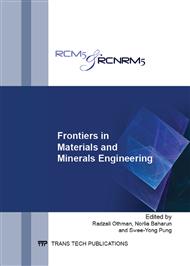p.56
p.60
p.67
p.74
p.80
p.88
p.96
p.103
p.111
Electrical Properties of LLDPE/SR with Nano-Silica and Nanoboron Nitride
Abstract:
Thermoplastic elastomer (TPE) nanocomposites based on 70:30 of linear low density polyethylene (LLDPE) and silicone rubber (SR) filled with nanosilica (SiO2) and nanoboron nitride (BN) was prepared. The effect of different types of nanofiller and sequence of blending on dielectric breakdown strength, dielectric properties and morphological properties of the blend was evaluated. The results showed that the presence of nanofiller improved the dielectric strength of LLDPE/SR. BN filled system had better dielectric strength as compared to SiO2 filled system. The addition of nanofillers also increased dielectric constant and dielectric loss of the blends. The sequence of blending significantly affected the properties of the material. The indirect blending (sample prepared master batch of SR/nanofiller) showed higher dielectric strength compared to the sample prepared through direct blending. The result was explained through SEM observation which showed the presence of fewer interfaces in the indirect blending sample, thus resulting in less weak points. This would have resulted in higher dielectric strength compared to direct blending sample which had various interfaces. The sample prepared through direct blending also showed remarkably higher dielectric contant and loss which is not suitable for insulator.
Info:
Periodical:
Pages:
80-87
Citation:
Online since:
November 2013
Authors:
Price:
Сopyright:
© 2014 Trans Tech Publications Ltd. All Rights Reserved
Share:
Citation:


